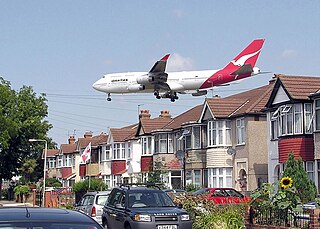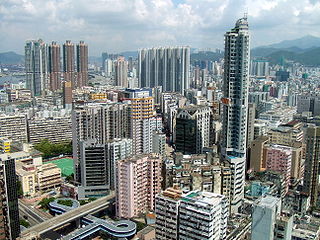Related Research Articles

In urban planning, zoning is a method in which a municipality or other tier of government divides land into "zones", each of which has a set of regulations for new development that differs from other zones. Zones may be defined for a single use, they may combine several compatible activities by use, or in the case of form-based zoning, the differing regulations may govern the density, size and shape of allowed buildings whatever their use. The planning rules for each zone determine whether planning permission for a given development may be granted. Zoning may specify a variety of outright and conditional uses of land. It may indicate the size and dimensions of lots that land may be subdivided into, or the form and scale of buildings. These guidelines are set in order to guide urban growth and development.

Noise pollution, or sound pollution, is the propagation of noise or sound with ranging impacts on the activity of human or animal life, most of which are harmful to a degree. The source of outdoor noise worldwide is mainly caused by machines, transport and propagation systems. Poor urban planning may give rise to noise disintegration or pollution, side-by-side industrial and residential buildings can result in noise pollution in the residential areas. Some of the main sources of noise in residential areas include loud music, transportation, lawn care maintenance, construction, electrical generators, wind turbines, explosions and people.

The term built environment refers to human-made conditions and is often used in architecture, landscape architecture, urban planning, public health, sociology, and anthropology, among others. These curated spaces provide the setting for human activity and were created to fulfill human desires and needs. The term can refer to a plethora of components including the traditionally associated buildings, cities, public infrastructure, transportation, open space, as well as more conceptual components like farmlands, dammed rivers, wildlife management, and even domesticated animals.
The ecology of Hong Kong is mostly affected by the results of climatic changes. Hong Kong's climate is seasonal due to alternating wind direction between winter and summer.

Kai Tak Airport(IATA: HKG, ICAO: VHHH) was an international airport of Hong Kong from 1925 until 1998. Officially known as Hong Kong International Airport from 1954 to 6 July 1998, it is often referred to as Hong Kong International Airport, Kai Tak, or simply Kai Tak and Kai Tak International Airport, to distinguish it from its successor, Chek Lap Kok International Airport, built on reclaimed and levelled land around the islands of Chek Lap Kok and Lam Chau, 30 kilometres (19 mi) to the west.

Land reclamation, usually known as reclamation, and also known as land fill, is the process of creating new land from oceans, seas, riverbeds or lake beds. The land reclaimed is known as reclamation ground,reclaimed land, or land fill.

Urban sprawl is defined as "the spreading of urban developments on undeveloped land near a more or less densely populated city". Urban sprawl has been described as the unrestricted growth in many urban areas of housing, commercial development, and roads over large expanses of land, with little concern for very dense urban planning. Sometimes the urban areas described as the most "sprawling" are the most densely populated. In addition to describing a special form of urbanization, the term also relates to the social and environmental consequences associated with this development. In modern times some suburban areas described as "sprawl" have less detached housing and higher density than the nearby core city. Medieval suburbs suffered from the loss of protection of city walls, before the advent of industrial warfare. Modern disadvantages and costs include increased travel time, transport costs, pollution, and destruction of the countryside. The revenue for building and maintaining urban infrastructure in these areas are gained mostly through property and sales taxes. As most jobs in the US are now located in suburbs generating much of the revenue, although a lack of growth will require higher tax rates.

A living street is a street designed with the interests of pedestrians and cyclists in mind by providing enriching and experiential spaces. Living streets also act as social spaces, allowing children to play and encouraging social interactions on a human scale, safely and legally. Living streets consider all pedestrians granting equal access to elders and those who are disabled. These roads are still available for use by motor vehicles; however, their design aims to reduce both the speed and dominance of motorized transport. The reduction of motor vehicle dominance creates more opportunities for public transportation.

Tai Kok Tsui is an area west of Mong Kok in Yau Tsim Mong district in the Kowloon region of Hong Kong. The mixed land use of industrial and residential is present in the old area. The Cosmopolitan Dock and oil depots were previously located there. Blocks of high-rise residential buildings have been erected on the reclaimed area to the west, which marked the revitalisation of the area with many restaurants and bars setting up shop. Many of the older residential buildings have been vacated and are set to be replaced by high-rise residential and commercial buildings.

A carfree city is an urban area absent of motor vehicles. Carfree cities rely on public transport, walking, and cycling for travel as opposed to motor vehicles. Districts where motor vehicles are prohibited are referred to as carfree zones. Carfree city models have gained traction in the second half of the 20th century due to issues with congestion and infrastructure, and proposed environmental and quality of life benefits. Many cities in Asia, Europe, and Africa have carfree areas due to the cities being created before the invention of motor vehicles, while many developing cities in Asia are using the carfree model to modernize their infrastructure.

Fairview Park is a substantial private residential estate in the Yuen Long District, New Territories, Hong Kong. It is unusual in Hong Kong for consisting of freestanding houses, rather than flats.

Tuen Mun Park, formerly known as Tuen Mun Town Park, is located in Tuen Mun, Hong Kong. It is the largest town park in the New Territories, covering 12.5 hectares.

There are multiple environmental issues in India. Air pollution, water pollution, garbage, domestically prohibited goods and pollution of the natural environment are all challenges for India. Nature is also causing some drastic effects on India. The situation was worse between 1947 through 1995. According to data collected and environmental assessments studied by World Bank experts, between 1995 through 2010, India has made some of the fastest progress in addressing its environmental issues and improving its environmental quality in the world. However, Pollution still remains a major challenge and opportunity for the country.
Manufacturing in Hong Kong consists of mainly light and labour-intensive industries. Manufacturing started in the 19th century after the Taiping Rebellion and continues today, although it has largely been replaced by service industries, particularly those involving finance and real estate.

The Hong Kong government started developing new towns in the 1950s to accommodate Hong Kong's booming population. During the first phase of development, the newly developed towns were called "satellite towns", a concept borrowed from the United Kingdom, of which Hong Kong was a colony. Kwun Tong, located in eastern Kowloon, and Tsuen Wan, located in the south-west of the New Territories, were designated as the first satellite towns, when the urban area in Hong Kong was still relatively small, restricted to the central and western parts of Kowloon Peninsula and the northern side of Hong Kong Island. Wah Fu Estate was also built in a remote corner on the southern side of Hong Kong Island, with similar concepts but at a smaller scale.
Islamabad has many environmental issues, severely affecting its biophysical environment as well as human health. The industrialization as well as lax environmental oversight have contributed to the problems. The various forms of pollution have increased as Karachi which has caused widespread environmental and health problems. Air pollution, lack of proper waste management infrastructure and degradation of water bodies are the major environmental issues in Karachi.

The scheme of revitalisation of industrial buildings was announced by the Government of Hong Kong in the 2009-2010 Policy address of Hong Kong. The aims of the scheme is to provide more floor spaces for suitable uses in order to meet Hong Kong’s changing social and economical needs. It aims to redevelop unused and affordable industrial buildings into space for new businesses, especially for the "six pillar industries".
Technical aspects of urban planning involve the technical processes, considerations and features that are involved in planning for land use, urban design, natural resources, transportation, and infrastructure.

Fai Ming Estate, former name "Fanling Area 49 Public Housing Development", is a public housing estate on Fai Ming Road in Fanling, New Territories, Hong Kong, next to Yung Shing Court. It was completed in 2019 and comprises two blocks with a total of 952 flats.

Environment and Ecology Bureau is one of the fifteen policy bureau of the Government of Hong Kong. The agency was established on 1 July 2022. The current Secretary for Environment and Ecology is Tse Chin-wan.
References
- 1 2 3 4 Ip, Kim Wai; Lam, Chi Chung; Wong, Kan Fai. "2.3". Exploring Geography. Exploring Geography. Vol. 1A (2 ed.). Hong Kong: Oxford University Press. pp. 55–57. ISBN 978-0-19-548660-5.
- ↑ Baba, Kevin; Fernandez, Bryan; Sermeno, Gabriel; Solanki, Swati. "Residential/Industrial land use" (PDF). Los Angeles. p. 6. Archived from the original (PDF) on 4 September 2006. Retrieved 16 February 2010.
- ↑ Clouser, Rodney L. and Olexa, Michael T. Issues at the rural-urban fringe: Florida state laws related to land use Archived 2010-06-26 at the Wayback Machine Retrieved 5 March 2010
- 1 2 3 Clouser, Rodney L. "Issues at the Rural-Urban Fringe: Land Use Conflicts". Florida: University of Florida. Archived from the original on 25 June 2010. Retrieved 16 February 2010.
- ↑ Ip, Kim Wai; Lam, Chi Chung; Wong, Kan Fai. "2.4". Exploring Geography. Exploring Geography. Vol. 1A (2 ed.). Hong Kong: Oxford University Press. pp. 60–64. ISBN 978-0-19-548660-5.